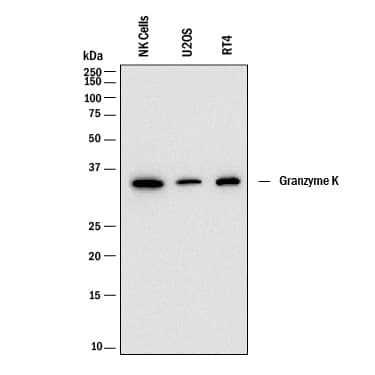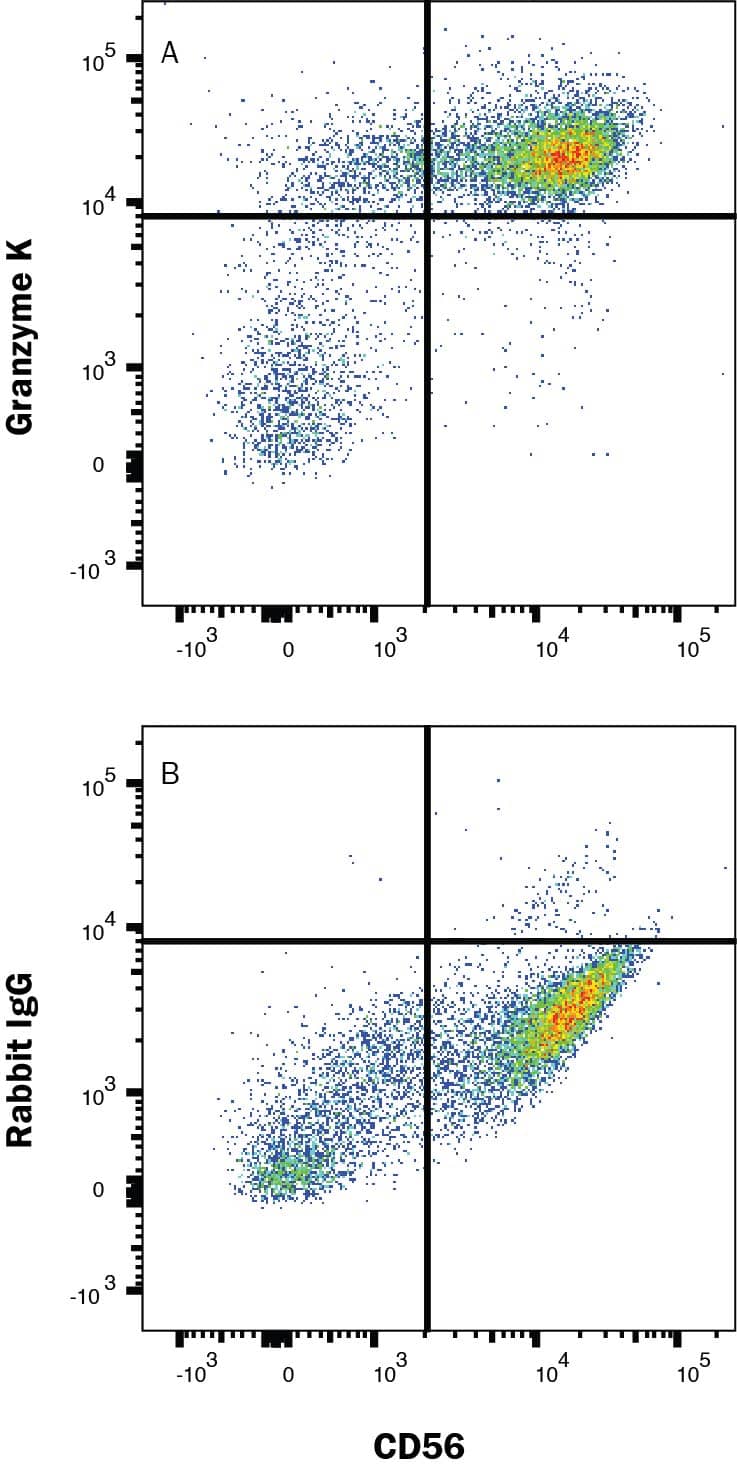Human Granzyme K Antibody
R&D Systems, part of Bio-Techne | Catalog # MAB10216
Recombinant Monoclonal Antibody.


Conjugate
Catalog #
Key Product Details
Species Reactivity
Validated:
Human
Cited:
Human
Applications
Validated:
Flow Cytometry, Immunohistochemistry, Western Blot
Cited:
Western Blot
Label
Unconjugated
Antibody Source
Monoclonal Rabbit IgG Clone # 2471A
Product Specifications
Immunogen
Synthetic peptide containing human Granzyme K
Accession # P49863
Accession # P49863
Specificity
Detects human Granzyme K in direct ELISAs.
Clonality
Monoclonal
Host
Rabbit
Isotype
IgG
Scientific Data Images for Human Granzyme K Antibody
Detection of Human Granzyme K by Western Blot.
Western blot shows lysates of human NK cells, U2OS human osteosarcoma cell line, and RT-4 human bladder carcinoma cell line. PVDF membrane was probed with 0.1 µg/mL of Rabbit Anti-Human Granzyme K Monoclonal Antibody (Catalog # MAB10216) followed by HRP-conjugated Anti-Rabbit IgG Secondary Antibody (HAF008). A specific band was detected for Granzyme K at approximately 30 kDa (as indicated). This experiment was conducted under reducing conditions and using Immunoblot Buffer Group 1.Granzyme K in Human Tonsil.
Granzyme K was detected in immersion fixed paraffin-embedded sections of human tonsil using Rabbit Anti-Human Granzyme K Monoclonal Antibody (Catalog # MAB10216) at 5 µg/mL for 1 hour at room temperature followed by incubation with the Anti-Rabbit IgG VisUCyte™ HRP Polymer Antibody (VC003). Before incubation with the primary antibody, tissue was subjected to heat-induced epitope retrieval using Antigen Retrieval Reagent-Basic (CTS013). Tissue was stained using DAB (brown) and counterstained with hematoxylin (blue). Specific staining was localized to cytoplasm in lymphocytes. View our protocol for IHC Staining with VisUCyte HRP Polymer Detection Reagents.Detection of Granzyme K in expanded Human NK cells by Flow Cytometry.
Detection of Granzyme K in expanded Human NK cells by Flow Cytometry. NK cells were expanded from Human peripheral blood mononuclear cells (PBMCs) for 14 days using ExCellerate™ Human NK Cell Expansion Media (CCM032). NK cells were stained with (A) Mouse Anti-Human Granzyme K Monoclonal Antibody (Catalog # MAB10216), followed by PE-conjugated anti-Rabbit IgG secondary antibody (F0110) and Rabbit Anti-Human CD56 Alexa Fluor® 647-conjugated Monoclonal Antibody (FAB24086R). (B) Quadrant markers were set based on control antibody staining (MAB1050). To facilitate intracellular staining, cells were fixed and permeabilized with FlowX FoxP3 Fixation & Permeabilization Buffer Kit (FC012). View our protocol for Staining Intracellular Molecules.Applications for Human Granzyme K Antibody
Application
Recommended Usage
Flow Cytometry
25 µg/mL
Sample: Human peripheral blood mononuclear cells (PBMCs)
Sample: Human peripheral blood mononuclear cells (PBMCs)
Immunohistochemistry
5-25 µg/mL
Sample: Immersion fixed paraffin-embedded sections of human tonsil
Sample: Immersion fixed paraffin-embedded sections of human tonsil
Western Blot
0.1 µg/mL
Sample: Human NK cells, U2OS human osteosarcoma cell line, and RT-4 human bladder carcinoma cell line
Sample: Human NK cells, U2OS human osteosarcoma cell line, and RT-4 human bladder carcinoma cell line
Formulation, Preparation, and Storage
Purification
Protein A or G purified from cell culture supernatant
Reconstitution
Reconstitute at 0.5 mg/mL in sterile PBS. For liquid material, refer to CoA for concentration.
Formulation
Lyophilized from a 0.2 μm filtered solution in PBS with Trehalose. *Small pack size (SP) is supplied either lyophilized or as a 0.2 µm filtered solution in PBS.
Shipping
Lyophilized product is shipped at ambient temperature. Liquid small pack size (-SP) is shipped with polar packs. Upon receipt, store immediately at the temperature recommended below.
Stability & Storage
Use a manual defrost freezer and avoid repeated freeze-thaw cycles.
- 12 months from date of receipt, -20 to -70 °C as supplied.
- 1 month, 2 to 8 °C under sterile conditions after reconstitution.
- 6 months, -20 to -70 °C under sterile conditions after reconstitution.
Background: Granzyme K
References
- Bots, M. and JP Medema (2006). J.Cell Sci. 119:5011.
- Walch, M. et al. (2014). Cell. 157:1309.
- Cullen, SP. et al. (2010). Cell Death Differ. 17:616.
Alternate Names
Fragmentin-3, Granzyme 3, Granzyme-K, GZMK, NK-Tryp-2, NK-Tryptase-2, TRYP2, Tryptase II
Gene Symbol
GZMK
UniProt
Additional Granzyme K Products
Product Documents for Human Granzyme K Antibody
Product Specific Notices for Human Granzyme K Antibody
For research use only
